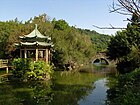The Huntington Library, Art Museum and Botanical Gardens, known as The Huntington, is a collections-based educational and research institution established by Henry E. Huntington (1850–1927) and Arabella Huntington (c.1851–1924) in San Marino, California, United States. In addition to the library, the institution houses an extensive art collection with a focus on eighteenth- and nineteenth-century European art and seventeenth- to mid-twentieth century American art. The property also has approximately 120 acres (49 ha) of specialized botanical landscaped gardens, including the "Japanese Garden", the "Desert Garden", and the "Chinese Garden".

Edo Castle is a flatland castle that was built in 1457 by Ōta Dōkan in Edo, Toshima District, Musashi Province. In modern times it is part of the Tokyo Imperial Palace in Chiyoda, Tokyo, and is therefore also known as Chiyoda Castle. Tokugawa Ieyasu established the Tokugawa shogunate there, and it was the residence of the shōgun and the headquarters of the military government during the Edo period (1603–1867) in Japanese history. After the resignation of the shōgun and the Meiji Restoration, it became the Tokyo Imperial Palace. Some moats, walls and ramparts of the castle survive to this day. However, the grounds were more extensive during the Edo period, with Tokyo Station and the Marunouchi section of the city lying within the outermost moat. It also encompassed Kitanomaru Park, the Nippon Budokan Hall and other current landmarks of the surrounding area.

Ginkaku-ji, officially named Jishō-ji, is a Zen temple in the Sakyo ward of Kyoto, Japan. It is one of the constructions that represents the Higashiyama Culture of the Muromachi period.

Japanese gardens are traditional gardens whose designs are accompanied by Japanese aesthetics and philosophical ideas, avoid artificial ornamentation, and highlight the natural landscape. Plants and worn, aged materials are generally used by Japanese garden designers to suggest a natural landscape, and to express the fragility of existence as well as time's unstoppable advance. Ancient Japanese art inspired past garden designers. Water is an important feature of many gardens, as are rocks and often gravel. Despite there being many attractive Japanese flowering plants, herbaceous flowers generally play much less of a role in Japanese gardens than in the West, though seasonally flowering shrubs and trees are important, all the more dramatic because of the contrast with the usual predominant green. Evergreen plants are "the bones of the garden" in Japan. Though a natural-seeming appearance is the aim, Japanese gardeners often shape their plants, including trees, with great rigour.
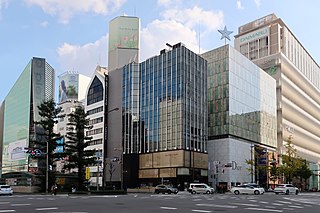
Shinsaibashi (心斎橋) is a district in the Chūō-ku ward of Osaka, Japan and the city's main shopping area. At its center is Shinsaibashi-suji (心斎橋筋), a covered shopping street, that is north of Dōtonbori and Sōemonchō, and parallel and east of Mido-suji street. Associated with Shinsaibashi, and west of Mido-suji street, is Amerika-mura, an American-themed shopping area and center of Osaka's youth culture. Major stores and boutiques concentrates are found around the area. Shinsaibashi is easily accessed via the subway.
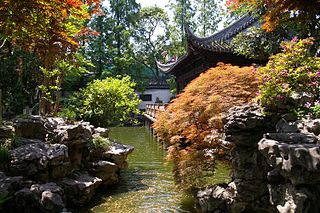
The Chinese garden is a landscape garden style which has evolved over three thousand years. It includes both the vast gardens of the Chinese emperors and members of the imperial family, built for pleasure and to impress, and the more intimate gardens created by scholars, poets, former government officials, soldiers and merchants, made for reflection and escape from the outside world. They create an idealized miniature landscape, which is meant to express the harmony that should exist between man and nature.

The Anji Bridge is the world's oldest open-spandrel segmental arch bridge of stone construction. Credited to the design of a craftsman named Li Chun, the bridge was constructed in the years 595–605 during the Sui dynasty (581–618). Located in the southern part of Hebei Province, it is the oldest standing bridge in China. It is considered one of the Four Treasures of Hebei.

Contemporary architecture is the architecture of the 21st century. No single style is dominant. Contemporary architects work in several different styles, from postmodernism, high-tech architecture and new interpretations of traditional architecture to highly conceptual forms and designs, resembling sculpture on an enormous scale. Some of these styles and approaches make use of very advanced technology and modern building materials, such as tube structures which allow construction of buildings that are taller, lighter and stronger than those in the 20th century, while others prioritize the use of natural and ecological materials like stone, wood and lime. One technology that is common to all forms of contemporary architecture is the use of new techniques of computer-aided design, which allow buildings to be designed and modeled on computers in three dimensions, and constructed with more precision and speed.

The Marco Polo Bridge or Lugou Bridge is a stone bridge located 15 km southwest of Beijing's city center in the Fengtai District. It bridges the Yongding River, a major tributary of Hai River. Situated at the eastern end of the bridge is the Wanping Fortress, a historic 17th-century fortress, with the Museum of the War of Chinese People's Resistance Against Japanese Aggression inside.

A moon gate is a circular opening in a garden wall that acts as a pedestrian passageway and is a traditional architectural element in Chinese gardens. The gates serve as an inviting entrance into the gardens of the rich upper class in China.

The Japanese Tea Garden in San Francisco, California, is a popular feature of Golden Gate Park, originally built as part of a sprawling World's Fair, the California Midwinter International Exposition of 1894. Though many of its attractions are still a part of the garden today, there have been changes throughout the history of the garden that have shaped it into what it is today.
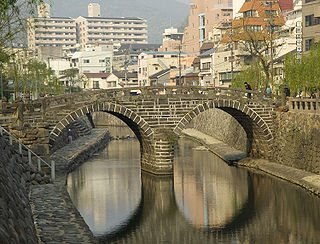
Meganebashi (眼鏡橋) or Spectacles Bridge, over the Nakashima River (中島川) was built in Nagasaki in 1634 by the Chinese monk Mokusunyoujo who was in the second generation of Chinese monks living at Kofukuji Temple. It is said to be the oldest stone arch bridge in Japan along with Edo's Nihonbashi bridge and Iwakuni's Kintaikyou bridge and has been designated as an Important Cultural Property. Megane Bridge is also part of the first group of bridges built over Nakashima river. Megane Bridge is made of stone and is a double arch bridge. It received the nickname "Spectacles Bridge" because its two arches and their reflection in the water create the image of a pair of spectacles. Vehicles are prohibited from crossing the bridge and is strictly prohibited to pedestrians only. On July 23, 1982, a disastrous deluge washed away six of the ten stone bridges over the Nakashima River. Meganebashi was badly damaged but almost all the original stones were retrieved and the bridge was restored to its original appearance. As well as being damaged in a flood in 1982 another flood in 1647 destroyed Megane Bridge but was rebuilt the following year in 1648 by Koumu Hirado.

Chinese Garden is a park in Jurong East, Singapore. Built in 1975 by the JTC Corporation and designed by Prof. Yuen-chen Yu, an architect from Taiwan, the Chinese Garden's concept is based on Chinese gardening art. The main characteristic is the integration of architectural features with the natural environment. The Chinese Garden is modeled along the northern Chinese imperial style of architecture and landscaping. It is located next to Chinese Garden MRT station and connected to the adjacent Japanese Garden by a bridge. Along with Japanese Garden, the two gardens are collectively known as the Jurong Gardens.

The Hōrai Bridge is a wooden pedestrian bridge over the Ōi River located in the city of Shimada, Shizuoka Prefecture, Japan. It was constructed in 1879. With a length of 897.422 metres (2,944.30 ft), the bridge was registered in The Guinness Book of Records as the longest wooden walking bridge in the world in 1997.

The Qingchuan Bridge is an arch bridge located in Wuhan, People's Republic of China. It is the fourth bridge on the Han River, the third motorway bridge and also the "Rainbow Bridge" due to its shape and red color. The bridge has a span of 280 m (919 ft), with a full length of 989.75 m (3,247.2 ft). The construction of this bridge begins on Dec 20, 1997, and completed in 2000, which started revenue service to the public. It has four lanes, connects Yanhe Ave in Hankou with Hannan Rd in Hanyang. It used to be a tolled bridge, but after the implementation of electronic toll collection in Wuhan, the toll plaza was razed.

The Eight Views of Ōmi are traditional scenic views of Ōmi Province which is now Shiga Prefecture in Japan.
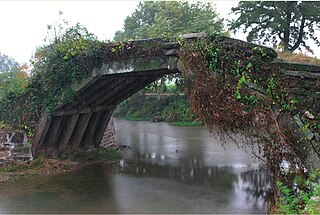
The Guyue Bridge is an arch bridge located in Yiwu, Zhejiang province, China.

The Saruhashi Bridge (猿橋) is a historic arch bridge officially listed as a Place of Scenic Beauty of Japan in Ōtsuki, Yamanashi Prefecture. It is ranked as one of Japan's three unique bridges, along with the Kintai Bridge and the Shinkyo Bridge. It is also referred to as the monkey bridge

A moon garden, also known as a twilight garden, evening garden, night garden, moonlight garden, or dream garden, is a type of garden designed to be enjoyed at dusk and nighttime. Fragrant flowers, light-colored vegetation or blooms that are visible by moonlight, blossoms that open at night instead of day, and plants which attract night pollinators you can hear, are all elements of a moon garden. The different effects produced by moonlight compared to sunlight in human color perception emphasize the colors of certain flowers more than others, bringing out different tones which are not available during daytime or with artificial lights. Night-blooming plants are typically moth, bat or wind pollinated. Planning an evening garden can perform double-duty as a setting for evening entertaining such as barbecues and parties.

Usui Bridge is the largest brick-masonry arched bridge in Japan, located over Usui river in Gunma prefecture. The bridge was built in 1892 for Usui railway line to travel between Yokokawa in Gunma prefecture and Karuizawa in Nagano prefecture. It was designed by a British engineer Charles Assheton Whately Pownall during the Meiji era, with some of the piers reaching heights of up to 110 feet (34 m).

